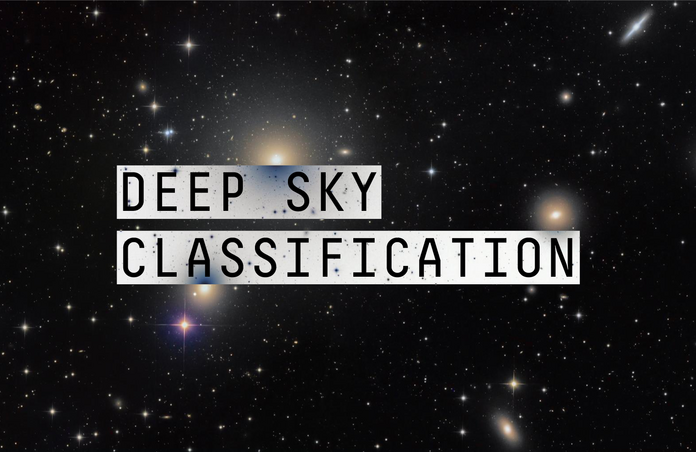Deep Sky Classification

Celestial objects which are not individual stars outside our Solar System are referred to as deep sky objects. These nebulae, star clusters and galaxies come in different types and arrangements. Here’s a brief overview of their classification with a list of objects you’ll just want to photograph in your first observation!
Nebulae
The word nebula comes from Latin and means cloud: a nebula is an interstellar cloud of gas and dust.
- Bright nebulae
This type of nebula is a region where stars will form, are forming or have been formed. It can be subdivided further into:
- Emission nebulae, which shine thanks to the hot, young stars inside them that radiate, up to the point where this “excites” or ionizes the surrounding gas, mainly Hydrogen, justifying its other name of HII region
Examples: the Eagle Nebula M16, the Rosette Nebula NGC 2237 and the Tarantula Nebula NGC 2070
- Reflection nebulae, which glow because they reflect surrounding star’s light as most of them aren’t hot enough to contain ionized gas and radiate on their own. If they are hot enough, they are a mixed type, emission/reflection nebula.
Examples: the Trifid Nebula M20, the nebula M78, the Witch Head Nebula IC 2118
- Supernova remnants, which as the name suggests are the “leftovers” a dying star ejects during its supernova phase – more about this in the article How do stars die?
Examples: the Crab Nebula M1, the Orion Nebula M42 and the Jellyfish Nebula IC 443 - Dark nebulae
These nebulae are colder than their bright counterparts and can be observed because they eclipse the stars behind them. Their darkness is also due to the fact that they contain dust grains, which by absorbing it prevent visible light from the few stars within the nebula from escaping.
A lot of people’s favourite example is the Horsehead Nebula B33, we also recommend the Pipe Nebula B78 and the Snake Nebula B72. - Planetary nebulae
In about 5 billion, that’s what alien astrophotographers will be able to see instead of our Solar System – our Sun will have ejected its outer envelope, only leaving a white dwarf star in the middle of this newly-formed planetary nebula. This white dwarf still radiates energy and is able to ionize the gas, which similarly to emission nebulae will glow.
Example targets: the Ring Nebula M57, the Helix Nebula NGC 7293 and the Cat’s Eye Nebula NGC 6543
Star Clusters
Once they have formed, stars formed from the same nebula may still be gravitationally bound. The main difference between the two types Open clusters and Globular clusters is that the first are found on the “outskirts”, the disk of a galaxy, whereas the latter are more “central”, in the halo of a galaxy. Globular clusters usually have a spherical shape while open clusters are more irregular. There are also so-called Associations, which are like open clusters but with less stars.
The Pleiades M45 are a popular target, as well as the Beehive M44, the Gem Cluster NGC 3293 and the globular cluster Omega Centauri.
Galaxies
Millions or even billions of stars can be gravitationally bound together with interstellar gas and dust, and let’s not forget the mysterious dark matter, within a system called galaxies. Like stars, individual galaxies can also become arranged in clusters, or even superclusters, which can include thousands of them.
Some of the most famous galaxies are the M51 Whirlpool Galaxy, our closest neighbour the Andromeda Galaxy M31 and the Antennae Galaxies NGC 4038 (composed of two colliding galaxies). These are good choices for your first imaging of a galaxy. It’s also possible for you to observe a part of the Virgo cluster, which contains about 1300 galaxies. To observe multiple galaxies at once but in more detail, Hickson Compact Groups are good targets, such as HCG 44 or Copeland's Septet HCG 57.
You can find more inspiration and can practice classifying celestial objects by looking at the Telescope Live Gallery https://telescope.live/gallery.
